Trip Report - 5-23-19
A Guided Trip on the Farmington
I rarely hire a guide, but this past Thursday was an exception. It turned out to be an exceptional day.
I went with Danny, a friend who loves to fish, who has purchased some very nice rods from me and who has almost no time to use them. I'm busy. He's much busier than I am. He works insane hours - and he has kids, so there is almost no time to just get away for and by himself.
On the rare occasions when he can get away to go fishing he always hires a guide. Lots of people I know think that finding the out-of-the-way places to fish is half the fun. Spending time exploring makes a lot of sense if you have a lot of time to explore. If your schedule lets you fish only a few days a year, you don't want to spend your days driving around looking for a place to fish. You want to FISH. What's more, if you're like most people, you want to CATCH. He puts it simply: "When I hire a guide I catch fish."
I asked him why he didn't just go back to the same spot a guide took him last time. He had a perfect answer. "If I go back to the same pool, and there's already three guys in the pool then what do I do? Going upstream or downstream gets back to exploring. I only have a limited amount of time. I want to fish, not drive around." I know the feeling. I have spent more than a few days in the Catskills looking for a nice place to fish, and every spot I wanted to fish already had people fishing it. Hours of driving and minutes of fishing is not a way to relax and let the stress from the real world wash away with the current.
So when Danny and I finally found a day we could both take off, we went together and hired Zach, a guide Danny had fished with before and with whom he'd had great days. Zach is a fly fishing guide, not a tenkara guide, and was more than a little skeptical when I said I would be fishing with a fixed line rod.
He had fished with a tenkara rod briefly on one of Danny's earlier trips with him, and he was convinced that a tenkara rod would not hold up to the fish he regularly catches. Since he regularly catches browns over 20", in current, I can certainly understand his concern. I know people who have caught 20+ inch fish with tenkara rods, but I also know people who have broken rods trying.
Partially to allay Zach's concern, and partially to have the best chance of landing a brute should I happen to hook one, I brought a Nissin Kyogi 21 carp rod instead of a tenkara rod. Zach was surprised by the length of the rod and maybe even a tiny bit impressed with the drifts that could be achieved and by how easily it handled the fish that I did manage to catch. And oh, yes, I did catch fish. No brutes, but big enough to put a bend in the Kyogi.
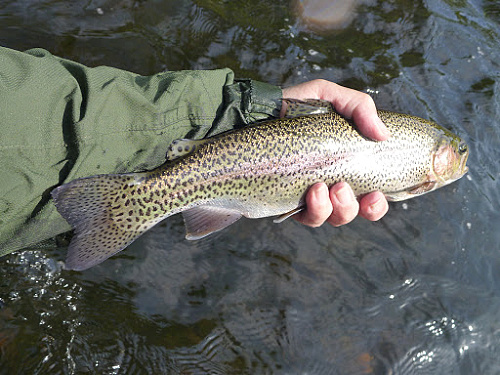
Danny caught fish, too, using one of Zach's fly rods. At the end of the day - or at least the end of the official guiding day, we all kind of broke out of the guide/client roles. Zach waded across the river and started to fish (he will not fish while he is guiding). Danny pulled out a TenkaraBum 40 and proceeded to catch a very nice fish on his second cast. I changed over from the rig that Zach had me use and put on a keiryu rig with yarn markers. During that time, I'm the only one who didn't catch nice fish.
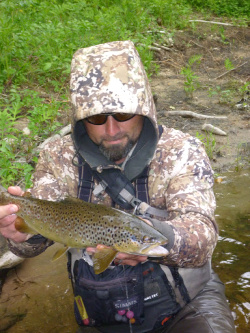 Zach with one of his browns
Zach with one of his browns(not one of his big ones)
In the past, I have hired guides - mostly when my friend Rex and I used to go to Florida bass fishing. Not only did the guides fish, they fished from the front of the boat. I couldn't help but think they were catching the fish we had come all the way to Florida for, and paid the guides to give us the chance to catch.
Zach won't fish while he is guiding. He is not going to catch the fish you are paying him so you can catch. At the end of the day, just before we broke down all the rods and called it a day, he showed us how it was done, catching two nice fish in rapid succession.
There is no way I could have caught those fish. Zach waded to the other side of the river - where I could not have gone if I had wanted to. Even with my wading staff, there is no way I could have gotten to the spot where he caught those fish.
And that cemented one of the main lessons of the day. Fish where others don't. I have fished the Farmington more than a few times, but I have never fished any of the places Zach took us. I always fished the well known places - you know, the ones that have names on the fishing maps. Zach doesn't fish those spots. Too many people. The Farmington is a popular river, and it gets crowded even on weekdays. (There are a surprising number of retired guys who like to fish.) For the entire day, we didn't have even one fisherman in sight in any of the spots Zach took us.
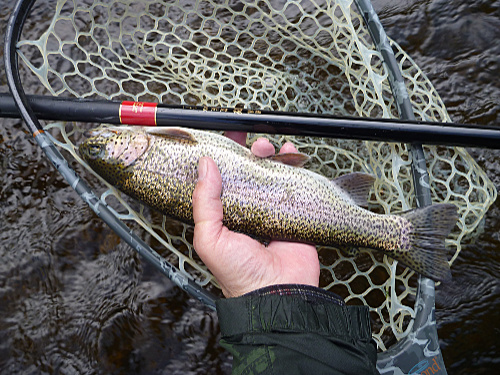
We did have fish, though, and in every spot. In retrospect, not fishing the popular spots seems like a no-brainer, but even though my hours aren't as crazy as Danny's, I still don't get that many days to fish and the Farmington is 2 1/2 hours away. That doesn't leave a lot of fishing time so it turns out I haven't spent a lot of exploring time either.
A second lesson, which again, should not have been a revelation, was the way Zach instructed us to manage our drifts. Tenkara anglers who have seen one of Rob Worthing's presentations on aerial mends would have immediately recognized Zach's drifts as Rob's Upstream Shallow presentation.
With two or three heavy beadhead nymphs on the line, it didn't end up being a shallow presentation, but the cast was mended so that the sighter was pointing in the exact direction of the drift. That virtually eliminates drag caused by the line crossing water flowing at different speeds. There is still an inescapable difference in the speed of the current on the surface and on the bottom, but Zach uses that current differential to his advantage.
I had written in my Ultralight Worm Fishing essay that the slight sag you get with even a light tenkara line turns out to be an extremely sensitive strike indicator. When the curvature from the sag goes away and the line goes straight, it's a fish. When fishing with weight, it could be a rock, too, though.
The interesting wrinkle with Zach's approach, though, is that if you are mindful of the degree of curvature from the line sag, it often can tell you when you in danger of getting snagged on the bottom - before you actually do get snagged.
Zach uses a long tippet, much longer than tenkara anglers use. With a longer line and shorter rod, the line is at a lower angle. At that low angle, the line sag turns out to be very sensitive to changes in the differential between the current speed at the surface and the current speed where your flies are.
Basically, the current right at the bottom is slower than the current even a little ways above the bottom, and much slower than the current at the surface. With a low line angle, if your line sag slowly straightens, it is likely to be because your point fly has gotten down to the slow water right near the bottom. The increased resistance of the fly being pulled through that slower water tightens the line. When that happens, your point fly is in immediate danger of getting snagged on rocks.
If a fish takes one of your flies, the sag doesn't straighten slowly. It straightens quickly. If you are mindful of the degree of line sag, it becomes pretty easy to tell the difference between your point fly getting near the bottom and your point fly getting taken by a fish.
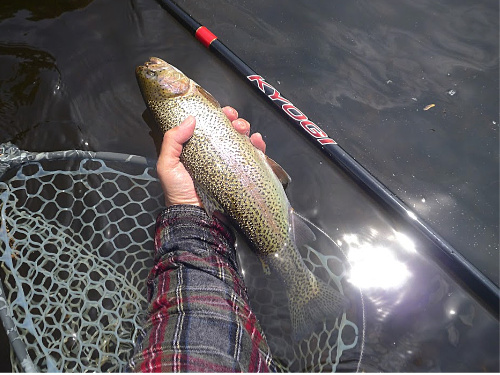
While I have played around a bit with Rob's Upstream Shallow presentation with unweighted wets and very lightly weighted bead heads, I have not tried it with two or three heavy flies like we used when fishing with Zach.
I have used line sag as a strike indicator when fishing with a light tenkara line and a worm with no added weight in shallow water, or just a single small split shot in slightly deeper water. I need to experiment with it when keiryu fishing with more weight and in deeper water.
Using a tenkara line and several small split shot instead of a keiryu line and a single BB shot would reduce the tendency of the line to want to hang straight down from the rod tip. I think I could fish further away and still get the good drifts that Zach and Rob are able to achieve.
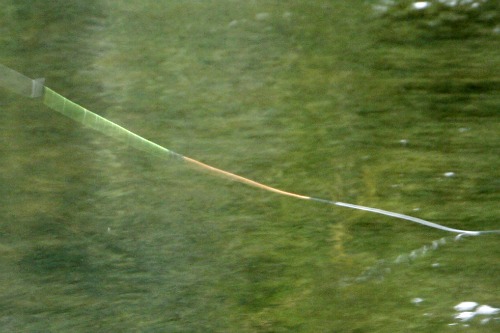 Tactical Nymphing Sighter
Tactical Nymphing SighterLine Sag
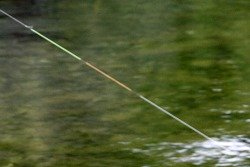 Tactical Nymphing Sighter
Tactical Nymphing SighterFish On
One thing I definitely will do, though, is use the TenkaraBum Tactical Nymphing Sighter instead of the pink and yellow Rio sighter that Zach uses. I find it to be much more visible.
I had a great day Thursday. In addition to catching a bunch of fish, I realized that a couple things I kind of knew were really a lot more applicable and a lot more important than I had given them credit for. In a nutshell, if you fish where most people don't fish, you can catch fish that most people don't catch. If you fish using the techniques you can learn from a good guide, like either Zach or Rob, you can catch fish that most people can't catch.
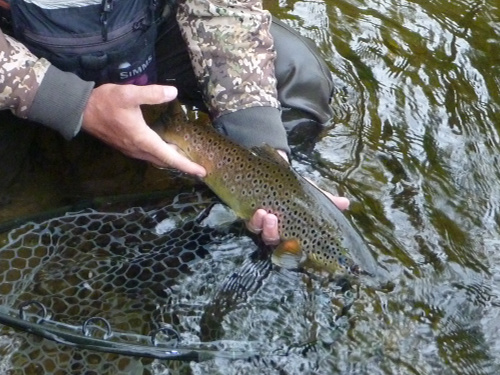 See you later!
See you later!TenkaraBum Home > Trip Reports > Trip Report 5-23-19
“The bitterness of poor quality remains long after the sweetness of low price is forgotten” - Benjamin Franklin
"Be sure in casting, that your fly fall first into the water, for if the line fall first, it scares or frightens the fish..." -
Col. Robert Venables 1662
As age slows my pace, I will become more like the heron.
Warning:
The hooks are sharp.
The coffee's hot.
The fish are slippery when wet.
Beware of the Dogma
This Just In
Tenryu Furaibo TF39, TF39TA
and TF32TA
Coming Soon
Latest Pages
Take an Old Fart Fishing
Old Geezer's Wide-Eyed
Flies™


